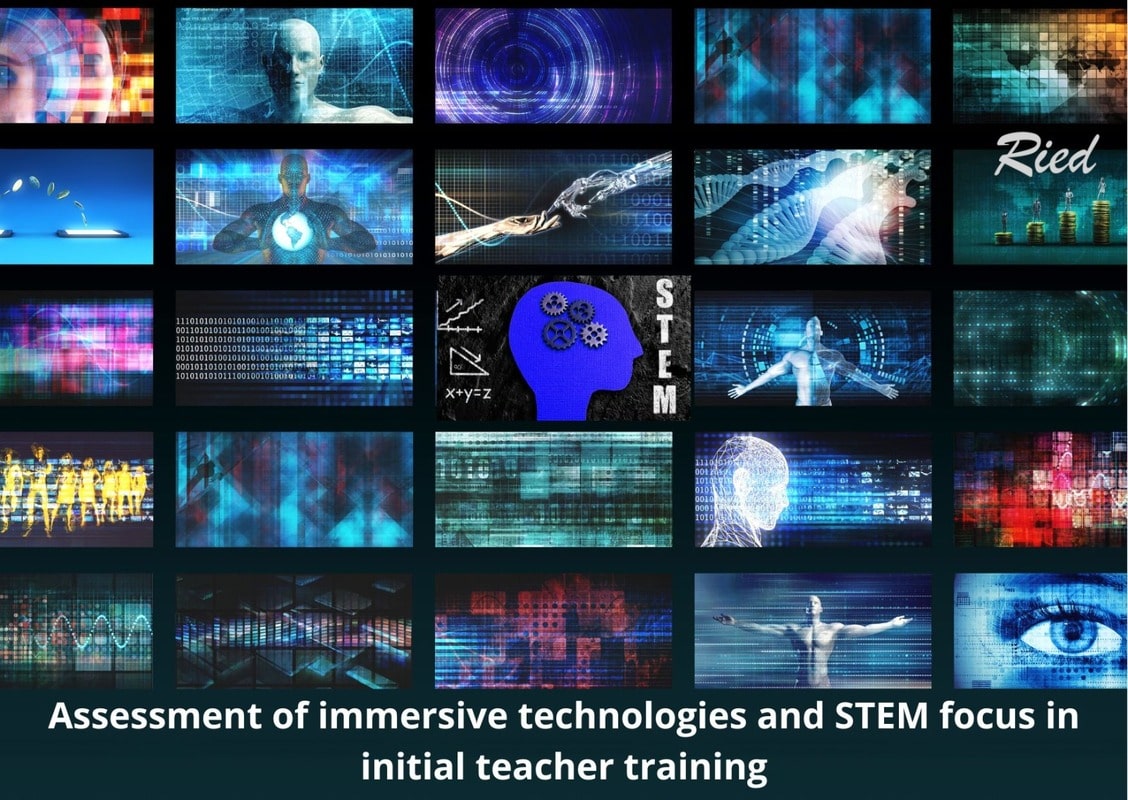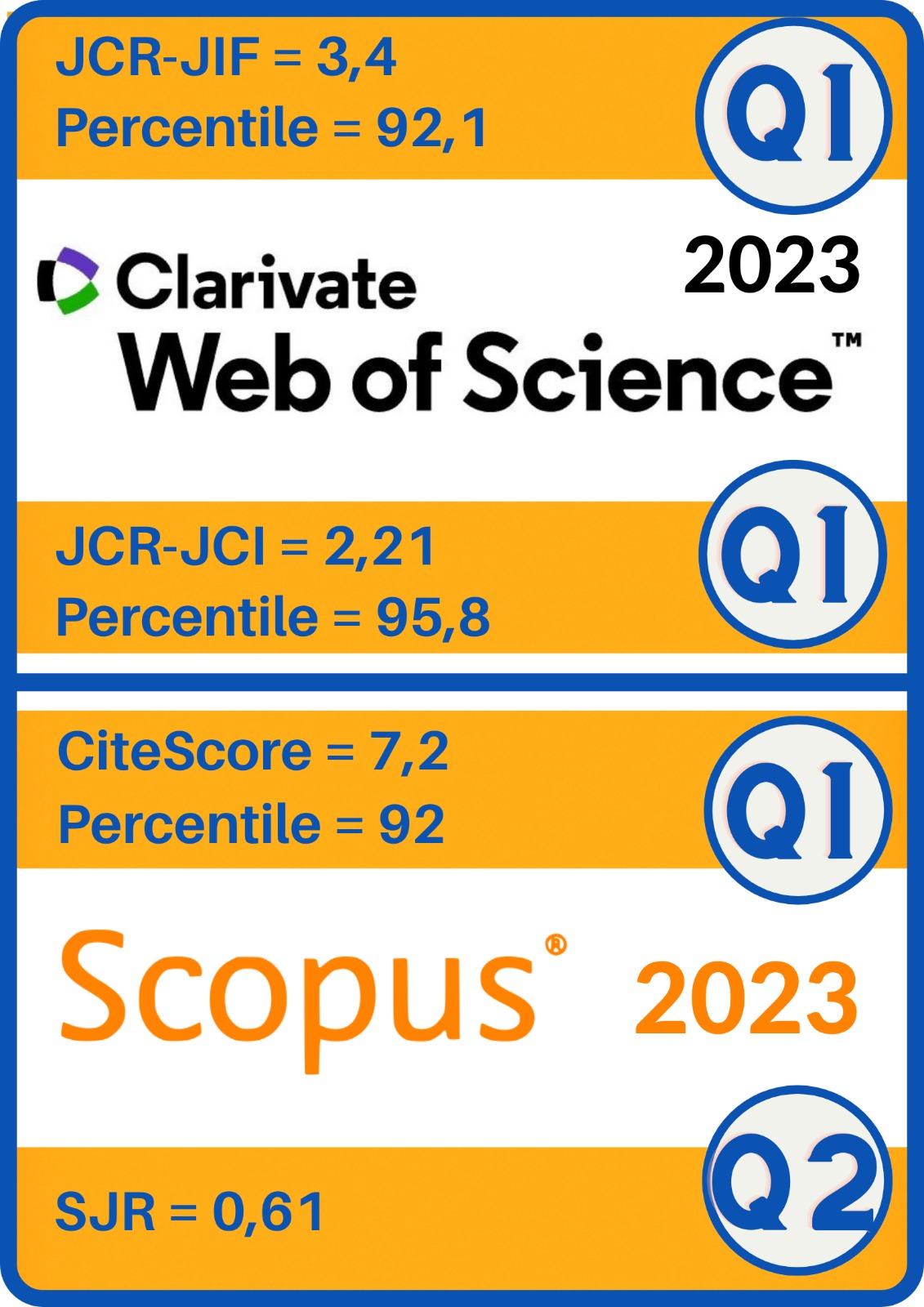Assessment of immersive technologies and STEM focus in initial teacher training
DOI:
https://doi.org/10.5944/ried.27.1.37688Keywords:
scientific education, educational technology, educational innovation, teacher education, didactics, STEM educationAbstract
In recent years, there has been a growing interest in the integration of various Emerging Technologies in the field of Education, especially immersive technologies such as Virtual Reality (VR) and Augmented Reality (AR). This research aims at assessing the perceived usefulness of these technologies by pre-service teachers at the Faculty of Educational Sciences of the University of Granada, specifically in the STEM field, and how they evaluate their potential for integration into their future teaching practices. A mixed-methods approach was used, including a pre-questionnaire administered to the entire population (N=544) to describe the participants' perceptions, followed by a post-test conducted with a subset (N=58) after having participated in a Complementary Training program focusing on the creation of immersive educational resources using the CoSpaces platform. The results revealed a high perceived utility of immersive technologies, highlighting their potential for enhancing teaching and learning in the STEM domain. However, challenges related to ease of integration and the lack of adequate training in the use of these technologies were identified. The importance of promoting teacher training and digital literacy to fully leverage the benefits of these emerging technologies in education is emphasized. Further research is suggested to delve into teacher training strategies and explore other educational contexts to expand the understanding of the implications and advantages of immersive technologies.
FULL ARTICLE:
https://revistas.uned.es/index.php/ried/article/view/37688/28246
Downloads
References
Aguilera, D., & Perales-Palacios, F. J. (2018). What effects do didactic interventions have on students’ attitudes towards science? A meta-analysis. Research in Science Education, 50, 573-597. https://doi.org/10.1007/s11165-018-9702-2
Álvarez, I. M., Manero, B., Morodo, A., Suñé-Soler, N., & Henao, C. (2023). Realidad Virtual Inmersiva para mejorar la competencia de gestión del clima del aula en secundaria. Educación XX1, 26(1), 249-272. https://doi.org/10.5944/educxx1.33418
Barroso, J., Gutiérrez-Castillo, J. J., Llorente-Cejudo, M. C., & Valencia, R. (2019). Difficulties in the incorporation of Augmented reality in university education: Visions from the experts. Journal of New Approaches in Educational Research, 8(2), 126. https://doi.org/10.7821/naer.2019.7.409
Boel, C., Rotsaert, T., Valcke, M., Rosseel, Y., Struyf, D., & Schellens, T. (2023). Are teachers ready to immerse? Acceptance of mobile immersive virtual reality in secondary education teachers. Research in Learning Technology, 31. https://doi.org/10.25304/rlt.v31.2855
Buss, R. R., Foulger, T. S., Wetzel, K., & Lindsey, L. (2018). Preparing teachers to integrate technology into K–12 instruction II: Examining the effects of technology-infused methods courses and student teaching. Journal of Digital Learning in Teacher Education, 34(3), 134-150. https://doi.org/10.1080/21532974.2018.1437852
Bybee, R. W. (2013). The case of STEM education: challenges and opportunities. National Science Teachers Association.
Cabello, V. M., Martinez, M. L., Armijo, S., & Maldonado, L. (2021). Promoting STEAM learning in the early years: “Pequeños Científicos” Program. LUMAT: International Journal on Math, Science and Technology Education, 9(2). https://doi.org/10.31129/LUMAT.9.2.1401
Cabero-Almenara, J., Romero-Tena, R., Llorente-Cejudo, C., & Palacios-Rodríguez, A. (2021). Academic Performance and Technology Acceptance Model (TAM) Through a Flipped Classroom Experience: Training of Future Teachers of Primary Education. Contemporary Educational Technology, 13(3), ep305. https://doi.org/10.30935/cedtech/10874
Cabero-Almenara, J., Vázquez-Cano, E., Villota-Oyarvide, W. R., & López-Meneses, E. (2021). La innovación en el aula universitaria a través de la realidad aumentada. Análisis desde la perspectiva del estudiantado español y latinoamericano. Revista Electrónica Educare, 25(3), 1-17. https://doi.org/10.15359/ree.25-3.1
Cardona, M. (2002). Introducción a los métodos de investigación en educación. EOS.
Chang, S. C., Hsu, T. C., Kuo, W. C., & Jong, M. S. Y. (2019). Effects of applying a VR-based two-tier test strategy to promote elementary students’ learning performance in a Geology class. British Journal of Educational Technology, 51(1), 148-165. https://doi.org/10.1111/bjet.12790
Cheng, K. H., & Tsai, C. C. (2020). Students’ motivational beliefs and strategies, perceived immersion and attitudes towards science learning with immersive virtual reality: A partial least squares analysis. British Journal of Educational Technology, 51(6) 2139-2158. https://doi.org/10.1111/bjet.12956
Chng, E., Tan, A. L., & Tan, S. C. (2023). Examining the use of emerging technologies in schools: A review of artificial intelligence and immersive technologies in STEM education. Journal for STEM Education Research. https://doi.org/10.1007/s41979-023-00092-y
Christensen, R. (2002). Effects of technology integration education on the attitudes of teachers and students. Journal of Research on Technology in Education, 34(4), 411-433. https://doi.org/10.1080/15391523.2002.10782359
Cviko, A., McKenney, S., & Voogt, J. (2014). Teacher roles in designing technology-rich learning activities for early literacy: A cross-case analysis. Computers & Education, 72, 68-79. https://doi.org/10.1016/j.compedu.2013.10.014
Del Moral Pérez, M. E., Neira Piñeiro, M. R., Castañeda Fernández, J., & López-Bouzas, N. (2022). Competencias docentes implicadas en el diseño de Entornos Literarios Inmersivos: conjugando proyectos STEAM y cultura maker. RIED-Revista Iberoamericana de Educación a Distancia, 26(1), 59-82. https://doi.org/10.5944/ried.26.1.33839
Dubé, A. K., & Wen, R. (2022). Identification and evaluation of technology trends in K-12 education from 2011 to 2021. Education and Information Technologies, 27(1), 1929-1958. https://doi.org/10.1007/s10639-021-10689-8
Ertmer, P. A., Ottenbreit-Leftwich, A. T., Sadik, O., Sendurur, E., & Sendurur, P. (2012). Teacher beliefs and technology integration practices: A critical relationship. Computers & Education, 59(2), 423–435. https://doi.org/10.1016/j.compedu.2012.02.001
Ferrada, C., Carrillo-Rosúa, F. J., Díaz-Levicoy, D., & Silva-Díaz, F. (2020). La robótica desde las áreas STEM en Educación Primaria: una revisión sistemática. Education in the Knowledge Society (EKS), 21(0), 18. https://doi.org/10.14201/eks.22036
Fleer, M. (2013). Affective imagination in science education: determining the emotional nature of scientific and technological learning of young children. Research in Science Education, 43(5), 2085-2106. https://doi.org/10.1007/s11165-012-9344-8
Freeman, A., Adams, S., Cummins, M., Davis, A., & Hall, C. (2017). NMC/CoSN Horizon Report: 2017 K-12 Edition. The New Media Consortium.
García-Vandewalle, J. M., García-Carmona, M., Trujillo Torres, J. M., & Moya-Fernández, P. (2022). The integration of emerging technologies in socioeconomically disadvantaged educational contexts. The view of international experts. Journal of Computer Assisted Learning, 38(4), 1185-1197. https://doi.org/10.1111/jcal.12677
Hernández Sampieri, R., Fernández Collado, C., & Baptista Lucio, M. (2014). Metodología de la investigación (6th ed.). McGraw-Hill Education.
Hod, Y. (2017). Future learning spaces in schools: Concepts and designs from the learning sciences. Journal of Formative Design in Learning, 1(2), 99-109. https://doi.org/10.1007/s41686-017-0008-y
Hung, D., & Khine, M. S. (Eds.). (2006). Engaged learning with emerging technologies. Springer-Verlag. https://doi.org/10.1007/1-4020-3669-8
Liu, R., Wang, L., Lei, J., Wang, Q., & Ren, Y. (2020). Effects of an immersive virtual reality‐based classroom on students’ learning performance in science lessons. British Journal of Educational Technology, 51(6), 2034-2049. https://doi.org/10.1111/bjet.13028
Lui, M., & Slotta, J. D. (2014). Immersive simulations for smart classrooms: exploring evolutionary concepts in secondary science. Technology Pedagogy and Education, 23(1), 57-80. https://doi.org/10.1080/1475939X.2013.838452
Makokha, J. (2017). Emerging technologies and science teaching. In K. S. Taber & B. Akpan (eds.), Science education (pp. 369-383). Sense Publishers. https://doi.org/10.1007/978-94-6300-749-8_27
Makransky, G., Petersen, G. B., & Klingenberg, S. (2020). Can an immersive virtual reality simulation increase students’ interest and career aspirations in science? British Journal of Educational Technology, 51(6), 2079-2097. https://10.1111/bjet.12954
Martín-Páez, T., Aguilera, D., Perales-Palacios, F. J., & Vílchez-González, J. M. (2019). What are we talking about when we talk about STEM education? A review of literature. Science Education, 103(4), 799–822. https://doi.org/10.1002/sce.21522
Martínez Pérez, S., & Fernández Robles, B. (2018). Objetos de Realidad Aumentada: percepciones del alumnado de Pedagogía. Pixel bit, 53, 207-220. https://doi.org/10.12795/pixelbit.2018.i53.14
Nikimaleki, M., & Rahimi, M. (2022). Effects of a collaborative AR‐enhanced learning environment on learning gains and technology implementation beliefs: Evidence from a graduate teacher training course. Journal of Computer Assisted Learning, 38(3), 758-769. https://doi.org/10.1111/jcal.12646
Nistor, N., Stanciu, D., Lerche, T., & Kiel, E. (2019). “I am fine with any technology, as long as it doesn’t make trouble, so that I can concentrate on my study”: A case study of university students’ attitude strength related to educational technology acceptance. British Journal of Educational Technology: Journal of the Council for Educational Technology, 50(5), 2557-2571. https://doi.org/10.1111/bjet.12832
Pellas, N., Fotaris, P., Kazanidis, I., & Wells, D. (2019). Augmenting the learning experience in primary and secondary school education: a systematic review of recent trends in augmented reality game-based learning. Virtual Reality, 23(4), 329-346. https://doi.org/10.1007/s10055-018-0347-2
Radianti, J., Majchrzak, T. A., Fromm, J., & Wohlgenannt, I. (2020). A systematic review of immersive virtual reality applications for higher education: Design elements, lessons learned, and research agenda. Computers & Education, 147(103778). https://doi.org/10.1016/j.compedu.2019.103778
Sanders, M. (2009). STEM, STEM education, STEMmania. The Technology Teacher, 68(4), 20-27.
Sánchez-Prieto, J. C., Huang, F., Olmos-Migueláñez, S., García-Peñalvo, F. J., & Teo, T. (2019). Exploring the unknown: The effect of resistance to change and attachment on mobile adoption among secondary pre‐service teachers. British Journal of Educational Technology: Journal of the Council for Educational Technology, 50(5), 2433-2449. https://doi.org/10.1111/bjet.12822
Silva-Díaz, F., Carrillo-Rosúa, J., & Fernández-Plaza, J. A. (2021). Uso de tecnologías inmersivas y su impacto en las actitudes científico-matemáticas del estudiantado de Educación Secundaria Obligatoria en un contexto en riesgo de exclusión social. Educar, 57(1), 119-138. https://doi.org/10.5565/rev/educar.1136
Silva-Díaz, F., Fernández-Ferrer, G., Vázquez-Vílchez, M., Ferrada, C., Narváez, R., & Carrillo-Rosúa, J. (2022). Tecnologías emergentes en la educación STEM. Análisis bibliométrico de publicaciones en Scopus y WoS (2010-2020). Bordón. Revista de Pedagogía, 74(4), 25-44. https://doi.org/10.13042/Bordon.2022.94198
Thibaut, L., Ceuppens, S., De Loof, H., De Meester, J., Goovaerts, L., Struyf, A., Boeve-de Pauw, J., Dehaene, W., Deprez, J., De Cock, M., Hellinckx, L., Knipprath, H., Langie, G., Struyven, K., Van de Velde, D., Van Petegem, P., & Depaepe, F. (2018). Integrated STEM education: A systematic review of instructional practices in secondary education. European Journal of STEM Education, 3(1). https://doi.org/10.20897/ejsteme/85525
Toma, R. B., & Greca, I. M. (2018). The effect of integrative STEM instruction on elementary students’ attitudes toward science. Eurasia Journal of Mathematics, Science and Technology Education, 14(4), 1383-1395. https://doi.org/10.29333/ejmste/83676
Toma, R. B., & Meneses-Villagrá, J. A. (2019). Preferencia por contenidos científicos de física o de biología en educación primaria: un análisis clúster. Revista Eureka sobre Enseñanza y Divulgación de las Ciencias, 16(1), 1104. https://doi.org/10.25267/Rev_Eureka_ensen_divulg_cienc.2019.v16.i1.1104
Xia, L., & Zhong, B. (2018). A systematic review on teaching and learning robotics content knowledge in K-12. Computers & Education, 127, 267-282. https://doi.org/10.1016/j.compedu.2018.09.007
Zollman, A. (2012). Learning for STEM literacy: STEM literacy for learning. School Science and Mathematics, 112(1), 12-19. https://doi.org/10.1111/j.1949-8594.2012.00101.x









